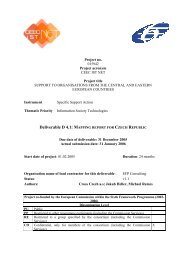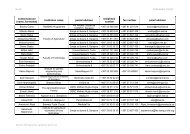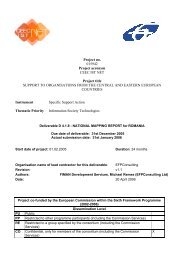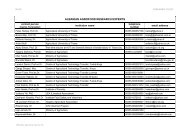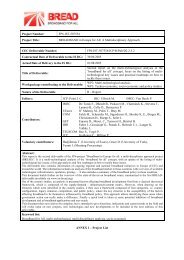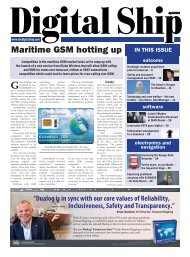Project Number: FP6-IST-507554 Project Title: BROADBAND in ...
Project Number: FP6-IST-507554 Project Title: BROADBAND in ...
Project Number: FP6-IST-507554 Project Title: BROADBAND in ...
You also want an ePaper? Increase the reach of your titles
YUMPU automatically turns print PDFs into web optimized ePapers that Google loves.
7.1.2 Home Networks 1 : Technologies / Standardisation<br />
Page 28 of 319<br />
<strong>FP6</strong>-<strong>IST</strong>-<strong>507554</strong>/JCP/R/Pub/D2.2-3.2<br />
High-speed Internet is spread<strong>in</strong>g. Homes that used to have little communication technology <strong>in</strong> the past now have<br />
multiple computers, peripherals like pr<strong>in</strong>ters and scanners, televisions, radios, stereos, DVD players, VCRs,<br />
cordless telephones, PDAs, and other electronic devices.<br />
Home networks l<strong>in</strong>k the many different electronic devices <strong>in</strong> a household by way of a local area network (LAN).<br />
The network can be po<strong>in</strong>t-to-po<strong>in</strong>t, such as connect<strong>in</strong>g one computer to another, or po<strong>in</strong>t-to-multipo<strong>in</strong>t where<br />
computers and other devices such as pr<strong>in</strong>ters, set-top boxes, and stereos are connected to each other and the<br />
Internet. There are many different applications for home network<strong>in</strong>g. They can be broken <strong>in</strong>to five categories:<br />
resource shar<strong>in</strong>g, communications, home controls, home schedul<strong>in</strong>g, and enterta<strong>in</strong>ment/<strong>in</strong>formation.<br />
Resource Shar<strong>in</strong>g<br />
Home network<strong>in</strong>g allows all users <strong>in</strong> the household to access the Internet and other applications at the same<br />
time. In addition, files (not just data, but also audio and video depend<strong>in</strong>g on the speed of the network) can be<br />
swapped, and peripherals such as pr<strong>in</strong>ters and scanners can be shared. There is no longer the need to have more<br />
than one Internet access po<strong>in</strong>t, pr<strong>in</strong>ter, scanner, or <strong>in</strong> many cases, software packages.<br />
Communications<br />
Home network<strong>in</strong>g allows easier and more efficient communication between users with<strong>in</strong> the household and<br />
better communication management with outside communications. Phone, fax, and e-mail messages can be<br />
routed <strong>in</strong>telligently. Access to the Internet can be atta<strong>in</strong>ed at multiple places <strong>in</strong> the home with the use of<br />
term<strong>in</strong>als and Webpads.<br />
Home Controls<br />
Home network<strong>in</strong>g can allow controls with<strong>in</strong> the house, such as temperature and light<strong>in</strong>g, to be managed though<br />
the network and even remotely through the Internet. The network can also be used for home security monitor<strong>in</strong>g<br />
with network cameras.<br />
Home Schedul<strong>in</strong>g<br />
A home network would allow families to keep one master schedule that could be updated from different access<br />
po<strong>in</strong>ts with<strong>in</strong> the house and remotely through the Internet.<br />
Enterta<strong>in</strong>ment/Information<br />
Home networks enable a multiple of options for shar<strong>in</strong>g enterta<strong>in</strong>ment and <strong>in</strong>formation <strong>in</strong> the home. Networked<br />
multi-user games can be played as well as PC-hosted television games. Digital video network<strong>in</strong>g will allow<br />
households to route video from DBS and DVDs to different set-top boxes, PCs, and other visual display devices<br />
<strong>in</strong> the home. Stream<strong>in</strong>g media such as Internet radio can be sent to home stereos as well as PCs.<br />
The speed of home networks is also important to consider. Most home network<strong>in</strong>g solutions have speeds of at<br />
least 1 Mbps, which is enough for most everyday data transmission (but may not be enough for bandwidth<strong>in</strong>tensive<br />
applications such as full-motion video). With the development of high-speed Internet access and<br />
digital video and audio comes a need for faster networks. Several k<strong>in</strong>ds of home networks can operate at speeds<br />
of 10 Mbps and up. Digital video network<strong>in</strong>g, for example, requires fast data rates. DBS MPEG-2 video requires<br />
3 Mbps and DVD requires between 3 and 8 Mbps. HDTV requires more speed than current home networks have<br />
but that should change <strong>in</strong> the future, as home networks get faster and as technology develops and adapts to new<br />
Internet appliances and digital media.<br />
In general, the home network<strong>in</strong>g standards can be divided <strong>in</strong>to two large groups: <strong>in</strong>-home network<strong>in</strong>g standards,<br />
that provide <strong>in</strong>terconnectivity of devices <strong>in</strong>side the home, and home-access network standards, that provide<br />
external access and services to the home via networks like cable TV, broadcast TV, phone net and satellite.<br />
Additionally, there are the mobile-service networks that provide access from mobile term<strong>in</strong>als when the user is<br />
away from home. Currently there is no dom<strong>in</strong>ant wired home network<strong>in</strong>g standard, and networks are likely to be<br />
heterogeneous. A comprehensive compilation of the standards for multimedia network<strong>in</strong>g is given <strong>in</strong> the<br />
MEDIANET2 project.<br />
1 Future Home, http://dbs.cordis.lu/ <strong>IST</strong>-2000-28133<br />
2 MediaNet, http://www.ist-ipmedianet.org/home.html



